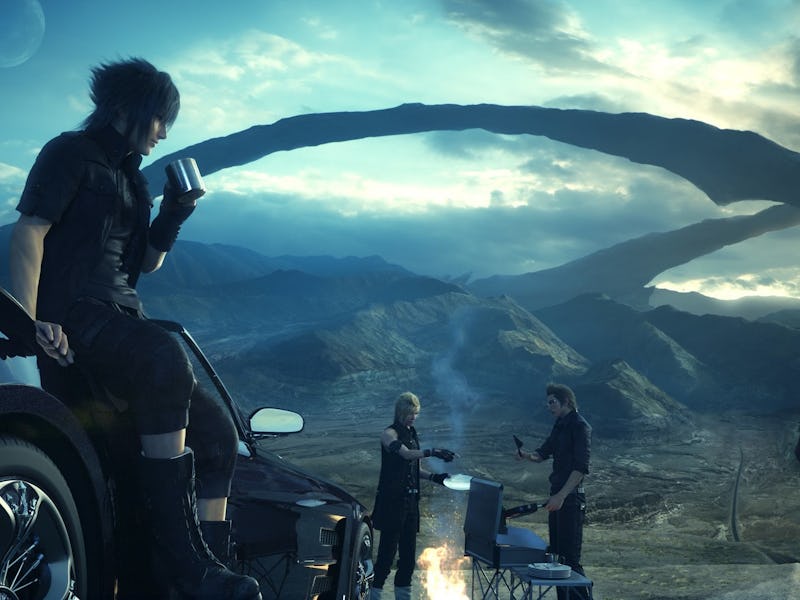How 'Final Fantasy XV' Will Save JRPGs
The release of 'Final Fantasy XV' marks the resurgence of a dying genre of games.

For the past decade, JRPGs — role-playing video games from Japan — have hosted a number of lackluster releases and disappointing failures. In some ways, it’s because of a lack of evolution from the genre’s heyday in the 90s, but it’s mainly due to one franchise: Final Fantasy.
JRPGs have both inspired and invigorated video gaming, and most fans will say that Final Fantasy is at the forefront of that influence. Because of that, the brand’s success is heavily tied to the success of the genre.
The Beginning of Eastern RPGs
Dungeons and Dragons 1991 boxed set
The beginning of all digital RPGs anywhere is most definitively Dungeons and Dragons, where designers and writers envisioned that immersive fantasy world transferring to the digital world. This started a line of different games like The Dragon and Princess (1982) and Bokosuka Wars (1983) in the east that had grid lines and text adventures.
It wasn’t until Black Onyx released in 1984 that the genre really started to take off in Japan. That title was the highest selling PC game of all time during that year. This paved the way for one of staples of the genre in Dragon Quest that simplified the genre for gamers, boiling down more complicated statistical fights to hit points, magic points, and experience points which made the genre of games more accessible to everyone.
Final Fantasy
After those releases by Square Co. (before having joined Enix and creating Square Enix in 2003) Final Fantasy tore through the gaming world with huge swords, pointy hair, and black magic in 1987. The fan favorite Final Fantasy 7 became JRPG’s frontrunner in 1997, twirling an elaborate story and giving us hours upon hours of exciting and entertaining gameplay. This was the game that popularized JRPGs outside of Japan and increased PlayStation sales, cementing the Final Fantasy brand for western audiences.
Final Fantasy became a household name with gamers, releasing successful games for another five years. Fans also went back to older installments like Final Fantasy IV. Final Fantasy X, received Best Game Award for the 2001-2002 year from the Japan Game Awards and as of 2013, the original and its sequel have sold over 14 million copies. That’s not even mentioning the HD remaster for the PS3 in 2013 (2014 for North America), for the PS4 in 2015, and for Steam this year.
The Decline
Final Fantasy X-2 wasn’t as good as the original. With new gameplay and no spunky main character, the deterioration continued with Final Fantasy XI, an online game that did so poorly that Square Enix had to overhaul the whole system and start over. Then the next game came out, and its characters were boring too. While Final Fantasy XII was still good despite the unimaginative main characters, it came out the same year as popular games such as Gears of War, The Legend of Zelda: Twilight Princess, and Metal Gear Solid 3. Thus, Final Fantasy XII shuffled into the sidelines and is now waiting on a pre-owned game shelf at GameStop.
And then there was Final Fantasy XIII. Initially, there were high hopes. It was a new start for the franchise; this would be the first game to appear on the PlayStation 3 and the company could remind gamers just why this franchise is one of the most influential and popular.
But it didn’t pan out and Final Fantasy XII dashed out our hopes with a convoluted story and dull characters. Some were fans of this addition to the brand – enough so that there were a shocking amount of sequels despite it being just one more average drudgery of JRPGs.
Shortly after the first of its three games, another game was announced — Final Fantasy Versus XIII.” This was going to take place in the same universe as Final Fantasy XIII and be directed by Tetsuo Nomura, one of the men behind the seventh and tenth Final Fantasy games. This was in 2006, and since then the game has been delayed and changed so much that its changed named to Final Fantasy XV*. It has a new director, and one of the only few similarities of the original is the main character. During those years of mediocre games and seemingly dropped projects, fans were losing faith and it was a lot of people’s belief that JRPGs were a dying breed.
However, this trend stayed alive through games like Shin Megami Tensei: Persona 4 which is actually the fifth installment in the Megami Tensei franchise coming out in 2008. It impressed gamers with its smart cohesion of dungeon fighting and high school life.
The Resurgence
It took years for Final Fantasy XV to become what it is now. We’re even approaching the ten year anniversary of its announcement at the E3 in 2006, but after the 2015 Pax Prime event where the game was officially revealed again with hints at a release, excitement grew. And it exploded even further this year in March with the “Uncovered: Final Fantasy XV event that gave us the release date, an anime, and a movie all in one swoop.
Hajime Tabata, the director of Final Fantasy XV is looking to modernize the brand from the stagnant state it was in before, commenting that “For XV, I sort of changed my mindset to make our aim of getting new players, and growing this global brand and appealing to sort of the mass-market new users.”
He wants to give the franchise the fresh start fans were hoping for back when Final Fantasy XIII was first announced, and by giving this pioneer of RPGs a bold update, *Final Fantasy XV” will lead gamers through an entirely new doorway in which to enjoy others of its kind.